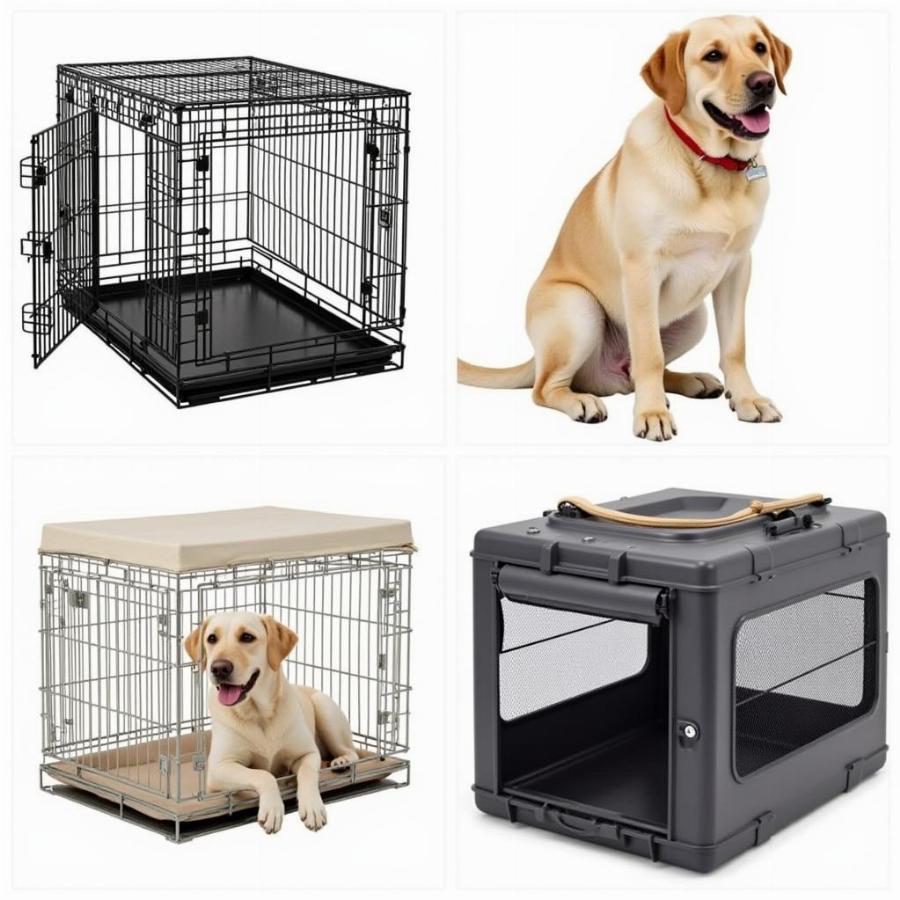Choosing the right dog crate for your Labrador Retriever is an important decision. A crate can be a valuable tool for housetraining, providing a safe space, and even aiding in travel. But with so many options available, it can be overwhelming to know where to start. This comprehensive guide will walk you through everything you need to know about selecting the perfect dog crate for your beloved Labrador, ensuring their comfort, safety, and happiness.
Why Use a Dog Crate for Your Labrador?
Many new Labrador owners wonder if a crate is truly necessary. The truth is, a crate, when used correctly, can be incredibly beneficial for both you and your furry friend.
- Housetraining: Labradors are intelligent dogs, but like all puppies, they need to learn the rules of the house. A crate provides a designated space and utilizes their natural instinct to avoid soiling their den.
- Safety and Security: A crate offers a secure haven for your Labrador, especially when you’re unable to supervise them directly. It prevents them from getting into potentially dangerous situations around the house, like chewing on electrical cords or ingesting harmful substances.
- Travel Companion: A crate makes traveling with your Labrador safer and less stressful for both of you. It provides a familiar and comforting space in the car and helps prevent distractions while driving.
- Recovery and Rest: If your Labrador is recovering from surgery or illness, a crate can be a useful tool to limit their activity and promote healing.
Choosing the Right Size Dog Crate for a Labrador
Selecting the correct crate size is crucial for your Labrador’s well-being. A crate that’s too small will be restrictive and uncomfortable, while a crate that’s too large defeats the purpose of den-like security and can even encourage accidents.
Here’s how to find the right fit:
- Measure Your Labrador: Measure your dog from the tip of their nose to the base of their tail (excluding the tail). Add 4-6 inches to this measurement to determine the minimum crate length.
- Consider Height: Ensure the crate is tall enough for your Labrador to stand up comfortably without their head touching the top.
- Growth Potential: For puppies, factor in their estimated adult size. You can consult breed standards or your veterinarian for guidance.
Size Guide for Labradors:
While the size of your Labrador will vary depending on their age and individual growth, here’s a general guideline:
- Labrador Puppies (up to 6 months): 30-inch crate
- Adult Labradors (female): 36-inch crate
- Adult Labradors (male): 40-inch crate
Types of Dog Crates for Labradors
Dog crates come in various materials, each offering pros and cons. Here are the most common types:
1. Wire Crates:
- Pros: Excellent ventilation, visibility, lightweight, affordable, foldable for storage.
- Cons: Can be less secure for escape artists, not as aesthetically pleasing.
2. Plastic Crates:
- Pros: Durable, secure, easy to clean, good for anxious dogs, airline-approved options available.
- Cons: Less ventilation, can be bulky, not as aesthetically pleasing.
 Dog Crate Options
Dog Crate Options
3. Soft-Sided Crates:
- Pros: Lightweight, portable, comfortable, good for travel.
- Cons: Less durable, not suitable for chewers or anxious dogs, not as easy to clean.
Tips for Crate Training Your Labrador
Crate training should be a positive experience for your Labrador. Here are some tips for success:
- Introduce the Crate Gradually: Make the crate inviting with a comfortable bed and safe toys.
- Feed Meals in the Crate: Start by placing their food bowl inside the crate to create positive associations.
- Use Positive Reinforcement: Reward your Labrador with treats and praise when they enter the crate calmly.
- Never Use the Crate as Punishment: The crate should always be a safe and positive space.
- Be Patient and Consistent: Crate training takes time and patience. Consistency is key to success.
Maintaining Your Labrador’s Crate
Keeping your Labrador’s crate clean and well-maintained is essential for their health and hygiene.
- Regular Cleaning: Remove bedding and wash it frequently. Wipe down the crate with pet-safe disinfectant.
- Check for Damage: Inspect the crate regularly for any loose parts or damage, and repair or replace as needed.
- Provide Comfort: Ensure the crate has a comfortable bed, adequate ventilation, and access to fresh water.
Conclusion
Choosing the right dog crate is an important step in providing a safe, secure, and comfortable environment for your Labrador Retriever. By understanding your dog’s needs, the different types of crates available, and the principles of crate training, you can make this experience positive and rewarding for both of you. Remember, a crate is a tool to aid in training and provide a safe haven—it should never be used for punishment.
For more helpful tips on dog care, training, and breed-specific information, be sure to check out our other articles on Beaut Dogs. When you need expert advice and reliable information, you can always count on Beaut Dogs to be your trusted resource. If you have any specific questions or need personalized guidance, don’t hesitate to reach out to us at [email protected]. We’re here to support you on your journey as a Labrador owner!